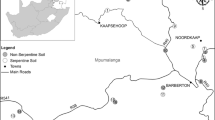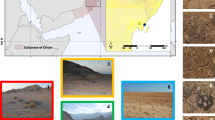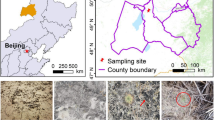Abstract
Biological soil crusts (BSCs) provide important ecosystem services in dryland regions, including erosion control and contribution to nitrogen and CO2 fixation. As soil microorganisms are still rarely studied within the context of biodiversity planning, we describe, as a contribution to the Soil Crust International project, an approach that addresses this gap in biodiversity assessments. The purpose of the present study was a characterization of prokaryotic communities of BSCs formed by two species of lichenized fungi, Psora decipiens and Toninia sedifolia, in relation to surrounding BSCs and the below-crust soil layer from Tabernas basin (Almería, Spain). Microbial community profiles were determined using 454 pyrosequencing targeting the V4 hypervariable region of the bacterial and archaeal 16S rRNA gene. The majority of the 65,497 sequences obtained belonged to Proteobacteria (mainly Alphaproteobacteria), Actinobacteria, Bacteroidetes and Cyanobacteria. Cyanobacteria were more abundant at the soil surface but rare in below-crust soils, whilst below-crust soils harbored significantly more Acidobacteria, Verrucomicrobia, Gemmatimonadetes, Planctomycetes and Armatimonadetes. Additionally, terricolous lichens were investigated using fluorescence in situ hybridization in conjunction with confocal laser scanning microscopy, the objective being to illustrate bacterial niches in BSC-forming lichens. Bacteria were mainly present at the upper cortex of the squamules and attachment organs. Our findings indicate that the composition of soil prokaryotes varies at a small scale not only in adjacent soil layers but also in BSC-forming lichen species. Furthermore, bacteria were shown to be attached to fungal structures, probably representing a case of fungal-bacterial interaction.









Similar content being viewed by others
References
Abed RMM, Kharusi SA, Schramm A, Robinson MD (2010) Bacterial diversity, pigments and nitrogen fixation of biological desert crusts from the Sultanate of Oman. FEMS Microbiol Ecol 72:418–428
Adeel Z (2008) Findings of the global desertification assessment by the millenium ecosystem assessment—a perspective for better managing scientific knowledge. In: Lee C, Schaaf T (eds) The future of drylands. Springer, Netherlands, pp 677–685
Amann R, Fuchs BM (2008) Single-cell identification in microbial communities by improved fluorescence in situ hybridization techniques. Nature Rev Microbiol 6:339–348
Barger NN, Herrick JE, Van Zee J, Belnap J (2006) Impacts of biological soil crust disturbance and composition on c and n loss from water erosion. Biogeochemistry 77:247–263
Bates ST, Cropsey GW, Caporaso JG, Knight R (2011a) Bacterial communities associated with the lichen symbiosis. Appl Environ Microbiol 77:1309–1314
Bates ST, Berg-Lyons D, Caporaso JG, Walters WA et al (2011b) Examining the global distribution of dominant archaeal populations in soil. ISME J 5:908–917
Belnap J (2003) The world at your feet: desert biological soil crusts. Front Ecol Environ 1:181–189
Belnap J, Eldridge D (2003) Disturbance and recovery of biological soil crusts. In: Belnap J, Lange OL (eds) Biological soil crusts: structure, function, and management, ecological studies, vol 150. Springer, Berlin, pp 363–383
Belnap J, Lange OL (2003) Biological soil crusts: structure, function, and management. In: Baldwin IT, Caldwell MM, Heldmaier G, Lange OL, Mooney HA, Schulze ED, Sommer U (eds) Ecological studies series 150, vol 150. Springer, Berlin
Bjelland T, Grube M, Hoem S, Jorgensen SL et al (2011) Microbial metacommunities in the lichen-rock habitat. Environ Microbiol Rep 3:434–442
Büdel B (2003) Biological soil crusts in European temperate and mediterranean regions. In: Belnap J, Lange OL (eds) Biological soil crusts: structure, function, and management, ecological studies, vol 150. Springer, Berlin, pp 75–87
Büdel B, Colesie C, Allan Green TG, Grube M et al (2014) Improved appreciation of the functioning and importance of biological soil crusts in Europe: the Soil Crust International Project (SCIN). Biodivers Conserv. doi:10.1007/s10531-014-0645-2
Cantón Y, Del Barrio G, Solé-Benet A, Lázaro R (2004) Topographic controls on the spatial distribution of ground cover in the Tabernas badlands of SE Spain. Catena 55:341–365
Caporaso JG, Kuczynski J, Stombaugh J, Bittinger K et al (2011) QIIME allows analysis of high-throughput community sequencing data. Nat Methods 7:335–336
Cardinale M, Puglia AM, Grube M (2006) Molecular analysis of lichen-associated bacterial communities. FEMS Microbiol Ecol 57:484–495
Cardinale M, Castro JV Jr, Müller H, Berg G, Grube M (2008) In situ analysis of the bacterial community associated with the reindeer lichen Cladonia arbuscula reveals predominance of Alphaproteobacteria. FEMS Microbiol Ecol 66:63–71
Cardinale M, Grube M, Berg G (2011) Frondihabitans cladoniiphilus sp., an actinobcterium of the family Microbacteriaceae isolated from lichen, and emended description of the genus Frondihabitans. Int J Syst Evol Microbiol 61:3033–3038
Castillo-Monroy AP, Bowker MA, Maestre FT, Rodríguez-Echeverría S et al (2011) Relationships between biological soil crusts, bacterial diversity and abundance, and ecosystem functioning: insights from a semi-arid Mediterranean environment. J Veg Sci 22:165–174
Chau JF, Bagtzoglou AC, Willig MR (2011) The effect of soil texture on richness and diversity of bacterial communities. Environ Forensics 12:333–341
Csotonyi JT, Swiderski J, Stackebrandt E, Yurkov V (2010) A new environment for aerobic anoxygenic phototrophic bacteria: biological soil crusts. Environ Microbiol Rep 2:651–656
Daims H (2009) Use of fluorescence in situ hybridization and the daime image analysis program for the cultivation-independent quantification of microorganisms in environmental and medical samples. Cold Spring Harb Protoc. doi:10.1101/pdb.prot5253
Daims H, Brühl A, Amann R, Schleifer KH, Wagner M (1999) The domain-specific probe EUB338 is insufficient for the detection of all bacteria: development and evaluation of a more comprehensive probe set. Syst Appl Microbiol 22:434–444
Demoling F, Figueroa D, Bååth E (2007) Comparison of factors limiting bacterial growth in different soils. Soil Biol Biochem 39:2485–2495
Dojani S, Büdel B, Deutschewitz K, Weber B (2011) Rapid succession of biological soil crusts after experimental disturbance in the succulent karoo, South Africa. App Soil Ecol 48:263–269
Dunkel FG (2003) Die Karlstadter Trockenrasen. Ein Pflanzenführer zu international bedeutsamen Magerrasen. Regierung von Unterfranken, Würzburg
Edgar RC, Haas BJ, Clemente JC, Quince C, Knight R (2011) UCHIME improves sensitivity and speed of chimera detection. Bioinformatics 27:2194–2200
Elbert W, Weber B, Büdel B, Andreae MO, Pöschl U (2009) Microbiotic crusts on soil, rock and plants: neglected major players in the global cycles of carbon and nitrogen? Biogeosci Discuss 6:6983–7015
Elbert W, Weber B, Burrows S, Steinkamp J (2012) Contribution of cryptogamic covers to the global cycles of carbon and nitrogen. Nat Geosci 5:1–4
Garcia-Pichel F, López-Cortés A, Nübel U (2001) Phylogenetic and morphological diversity of cyanobacteria in soil desert crusts from the Colorado Plateau. Appl Environ Microbiol 67:1902–1910
Göransson H, Venterink HO, Bååth E (2011) Soil bacterial growth and nutrient limitation along a chronosequence from a glacier forefield. Soil Biol Biochem 43:1333–1340
Griffiths RI, Thomson BC, James P, Bell T et al (2011) The bacterial biogeography of British soils. Environ Microbiol 13:1642–1654
Grube M, Cardinale M, Castro JV Jr, Müller H (2009) Species-specific structural and functional diversity of bacterial communities in lichen symbioses. ISME J 3:1105–1115
Gundlapally SR, Garcia-Pichel F (2006) The community and phylogenetic diversity of biological soil crusts in the Colorado Plateau studied by molecular fingerprinting and intensive cultivation. Microbiol Ecol 52:345–357
Hodkinson BP, Lutzoni F (2009) A microbiotic survey of lichen-associated bacteria reveals a new lineage from the Rhizobiales. Symbiosis 49:163–180
Hodkinson BP, Neil RG, Schadt CW, Lutzoni F (2012) Photoautotrophic symbiont and geography are major factors affecting highly structured and diverse bacterial communities in the lichen microbiome. Environ Microbiol 14:147–161
Johnson SL, Garcia-Pichel F, Youngkin D, Belnap J (2003) Small-scale vertical distribution of bacterial biomass and diversity in biological soil crusts from arid lands in the Colorado Plateau. Microb Ecol 46:312–321
Köberl M, Müller H, Ramadan EM, Berg G (2011) Desert farming benefits from microbial potential in arid soils and promotes diversity and plant health. PloS ONE 6:e24452–e24452. doi:10.1371/journal.pone.0024452
Kuske CR, Ticknor LO, Miller ME, Dunbar JM et al (2002) Comparison of soil bacterial communities in rhizospheres of three plant species and the interspaces in an arid grassland. Appl Environ Microbiol 68:1854–1863
Kuske CR, Yeager CM, Johnson S, Ticknor LO, Belnap J (2012) Response and resilience of soil biocrust bacterial communities to chronic physical disturbance in arid shrublands. ISME J 6:886–897
Langhans TM, Storm C, Schwabe A (2009) Community assembly of biological soil crusts of different successional stages in a temperate sand ecosystem, as assessed by direct determination and enrichment techniques. Microb Ecol 58:394–407
Lauber CL, Hamady M, Knight R, Fierer N (2009) Pyrosequencing-based assessment of soil pH as a predictor of soil bacterial community structure at the continental scale. Appl Environ Microbiol 75:5111–5120
Loy A, Maixner F, Wagner M, Horn M (2007) probeBase—an online resource for rRNA-targeted oligonucleotide probes: new features 2007. Nucleic Acids Res. doi:10.1093/nar/gkl856
Lozupone C, Knight R (2005) UniFrac : a new phylogenetic method for comparing microbial communities. Appl Environ Microbiol 71:8228–8235
Lozupone C, Lladser ME, Knights D, Stombaugh J, Knight R (2011) UniFrac: an effective distance metric for microbial community comparison. ISME J 5:169–172
Maestre FT, Bowker MA, Cantón Y, Castillo-Monroy AP et al (2011) Ecology and functional roles of biological soil crusts in semi-arid ecosystems of Spain. J Arid Environ 75:1282–1291
Matias Rodrigues JF, von Mering (2014) HPC-CLUST: distributed hierarchical clustering for large sets of nucleotide sequences. Bioinformatics 30:287–288
Moquin SA, Garcia JR, Brantley SL, Takacs-Vesbach CD et al (2012) Bacterial diversity of bryophyte-dominant biological soil crusts and associated mites. J Arid Environ 87:110–117
Muggia L, Klub B, Berg G, Grube M (2013) Localization of bacteria in lichens from Alpine soil crusts by fluorescence in situ hybridization. Appl Soil Ecol 68:20–25
Nagy ML, Garcia-Pichel F, Pérez A (2005) The prokaryotic diversity of biological soil crusts in the Sonoran Desert (Organ Pipe Cactus National Monument, AZ). FEMS Microbiol Ecol 54:33–245
Nawrocki EP, Kolbe DL, Eddy SR (2009) Infernal 1.0: inference of RNA alignments. Bioinformatics 25:1335–1337
Oksanen J, Guillaume Blanchet F, Kindt R, Legendre P et al (2013) Vegan: community ecology package. http://cran.r-project.org/web/packages/vegan/vegan.pdf. Accessed 1 Aug 2013
Parker SS (2010) Buried treasure: soil biodiversity and conservation. Biodivers Conserv 19:3743–3756
Peel MC, Finlayson BL, Mcmahon TA (2007) Updated world map of the Köppen–Geiger climate classification. Hydrol Earth Syst Sci 11:1633–1644
Pointing SB, Belnap J (2012) Microbial colonization and controls in dryland systems. Nat Rev Microbiol 10:551–562
Price MN, Dehal PS, Arkin AP (2010) FastTree 2—approximately maximum-likelihood trees for large alignments. PLoS ONE 5:e9490. doi:10.1371/journal.pone.0009490
R Core Team (2013) R: a language and environment for statistical computing. R Foundation for Statistical Computing, Vienna, Austria. http://www.R-project.org/. Accessed 1 Jan 2013
Reeder J, Knight R (2010) Rapidly denoising pyrosequencing amplicon reads by exploiting rank-abundance distributions. Nat Methods 7:668–669
Schneider T, Schmid E, de Castro JV, Jr Cardinale M et al (2011) Structure and function of the symbiosis partners of the lung lichen (Lobaria pulmonaria L. Hoffm.) analyzed by metaproteomics. Proteomics 11:2752–2756
Schüller H (1969) Die CAL-Methode, eine neue Methode zur Bestimmung des pflanzenverfügbaren Phosphates in Böden. Z Pflanzenernähr Bodenkd 123:48–63
Sessitsch A, Weilharter A, Gerzabek MH, Kirchmann H, Kandeler E (2001) Microbial population structures in soil particle size fractions of a long-term fertilizer field experiment. Appl Environ Microbiol 67:4215–4224
Soule T, Anderson IJ, Johnson SL, Bates ST et al (2009) Archaeal populations in biological soil crusts from arid lands in North America. Soil Biol Biochem 41:2069–2074
Souza-Egipsy V, Ascaso C, Sancho LG (2002) Water distribution within terricolous lichens revealed by scanning electron microscopy and its relevance in soil crust ecology. Mycol Res 106:1367–1374
Spain AM, Krumholz LR, Elshahed MS (2009) Abundance, composition, diversity and novelty of soil Proteobacteria. ISME J 3:992–1000
Stark M, Berger SA, Stamatakis A, von Mering C (2010) MLTreeMap—accurate Maximum Likelihood placement of environmental DNA sequences into taxonomic and functional reference phylogenies. BMC Genom 11:461–471
Steven B, Gallegos-Graves LV, Belnap J, Kuske CR (2013) Dryland soil microbial communities display spatial biogeographic patterns associated with soil depth and soil parent material. FEMS Microbiol Ecol 86:1–13
Visconti F, de Paz JM, Rubio JL (2010) What information does the electrical conductivity of soil water extracts of 1 to 5 ratio (w/v) provide for soil salinity assessment of agricultural irrigated lands? Geoderma 154:387–397
Wallner G, Amann R, Beisker W (1993) Optimizing fluorescent in situ hybridization with rRNA-targeted oligonucleotide probes for flow cytometric identification of microorganisms. Cytometry 14:136–143
Wang Q, Garrity GM, Tiedje JM, Cole JR (2007) Naive Bayesian classifier for rapid assignment of rRNA sequences into the new bacterial taxonomy. Appl Environ Microbiol 73:5261–5267
Warmink JA, Nazir R, van Elsas JD (2009) Universal and species-specific bacterial “fungiphiles” in the mycospheres of different basidiomycetous fungi. Environ Microbiol 11:300–312
White JR, Nagarajan N, Pop M (2009) Statistical methods for detecting differentially abundant features in clinical metagenomic samples. PLoS Comput Biol 5:e1000352. doi:10.1371/journal.pcbi.1000352
Yeager CM, Kornosky JL, Housman DC, Grote EE et al (2004) Diazotrophic community structure and function in two successional stages of biological soil crusts from the Colorado Plateau and Chihuahuan Desert. Appl Environ Microbiol 70:973–983
Zarda B, Hahn D, Chatzinotas A, Schönhuber W et al (1997) Analysis of bacterial community structure in bulk soil by in situ hybridization. Arch Microbiol 168:185–192
Zhang B, Zhang Y, Downing A, Niu Y (2011) Distribution and composition of cyanobacteria and microalgae associated with biological soil crusts in the Gurbantunggut Desert, China. Arid Land Res Manag. doi:10.1080/15324982.2011.565858
Acknowledgments
This research was funded by the ERA-Net BiodivERsA, with the national funder Austrian Science Foundation (Fonds zur Förderung der wissenschaftlichen Forschung; FWF-1799), part of the 2011 BiodivERsA call for research proposals. We would like to thank La Estación Experimental de Zonas Áridas, particularly Dr. Roberto Lázaro Suau, for allowing us to use their laboratory facilities. We wish to thank two anonymous reviewers for constructive comments that greatly improved the quality of the manuscript. We express our thanks to Toby Spribille, Ines A. Aschenbrenner and Barbara Klug, for helpful comments on the manuscript.
Author information
Authors and Affiliations
Corresponding author
Additional information
Communicated by Guest Editors of S.I.: Biocrust.
Electronic supplementary material
Below is the link to the electronic supplementary material.
Rights and permissions
About this article
Cite this article
Maier, S., Schmidt, T.S.B., Zheng, L. et al. Analyses of dryland biological soil crusts highlight lichens as an important regulator of microbial communities. Biodivers Conserv 23, 1735–1755 (2014). https://doi.org/10.1007/s10531-014-0719-1
Received:
Revised:
Accepted:
Published:
Issue Date:
DOI: https://doi.org/10.1007/s10531-014-0719-1




